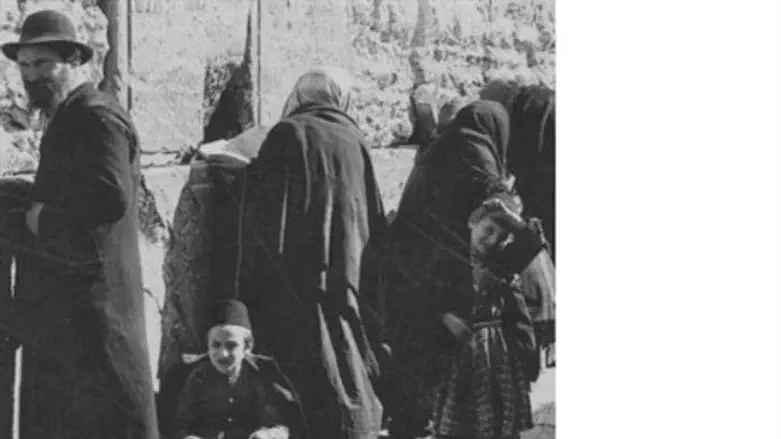
Boys at the Western Wall, some almost certainly posed by the photographer, Felix Bonfils, in the 1870s. Enlargement below is from the picture underneath. (Getty Research Institute). View a similar photo from the Library of Congress collection.
Felix Bonfil's photograph (Getty)
Known as the Wailing Wall, the Kotel HaMaaravi, or the Jews' Wailing Place, the prayer site was the focus of every photographer in Jerusalem.
Two years ago we posted a feature on "The Women of the Western Wall," and noted that there were no physical partitions between the men and the women visible in the pictures because of restrictions imposed by the Ottoman authoritiesand demands by the Muslim Mufti of Jerusalem. Any attempt to set up screens or bring chairs were met with protests and attacks. The Jewish worshippers honored a separation of sexes, for the most part.
"The Jews' Wailing Place" (circa 1900). Take a closer look below. Credit: Keystone-Mast Collection, California Museum of Photography at UCR ARTSblock, University of California, Riverside)
The picture below, from the University of California - Riverside collection, appears to be a typical picture of the Kotel at the turn of the 20th century, but it's not.Enlargement of the photo shows a group of children begging with their hands outstretched to men on the left, men whose hats suggest that they are visitors from overseas.
Children with their hands extended. The Jews of Jerusalem were remarkably poor under the Turkish rule, and relied on charitable donations from Jews in Europe and North America.
More Children at the KotelCredit: Keystone-Mast Collection, California Museum of Photography at UCR ARTSblock, University of California, Riverside)
An earlier feature here showed hundreds of Jewish children in 1918 returning to the Old City from a field trip on the Jewish holiday of Lag B'Omer.Are some of these the same children?
Jewish children's procession on Lag B'Omer 1918. (Library of Congress)


